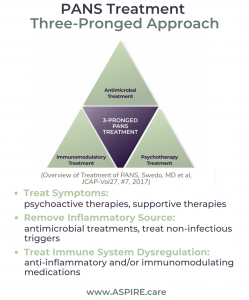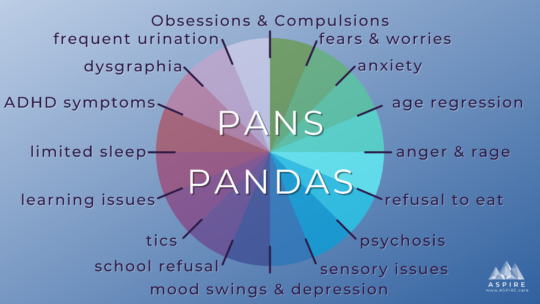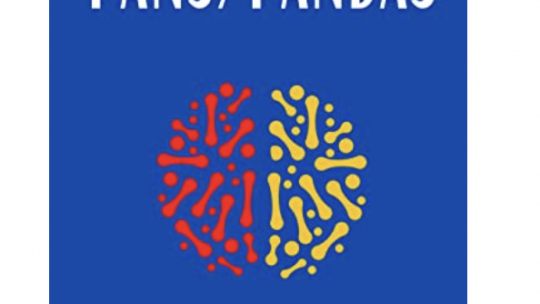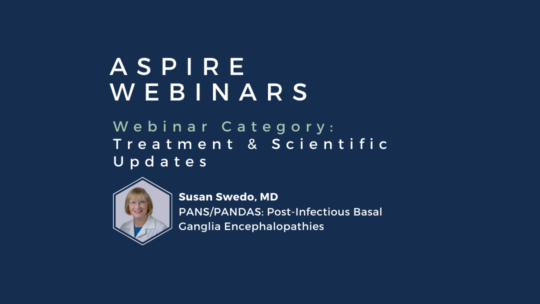
New Autism Rates Published – 1 in 36
CDC’s Autism Numbers – 1 in 36 The newly published estimated Autism Prevalence rates by the Center for Disease Control and Prevention (CDC) report that 1 in 36 children...
PANS Consensus Statement on Diagnosing PANS and PANDAS –Clinical Evaluation of Youth with Pediatric Acute-Onset Neuropsychiatric Syndrome (PANS): Recommendations from the 2013 PANS Consensus Conference. Chang, MD et al (JCAP, Vol 25, No 1, 2015 Mary Ann Liebert, Inc.)
PANS PANDAS Symptoms PANS Consensus Statement
More on the PANS Diagnostic Process
The PANDAS Physicians Network (PPN) flowcharts for diagnosis and treatment will help clinicians evaluate their patients and determine the best course of treatment. Guidelines and workflows were approved by practitioners of the PANDAS Physicians Network Scientific Advisory Board. More detailed resources are available at www.pandasppn.org. Diagnosing and treating should be done by a licensed healthcare provider.
Primary care providers play important, ongoing roles in the diagnosis, treatment, and recovery of children with PANS/PANDAS. Children with a moderate or severe/life-threatening onset or a complex presentation may require treatment by an experienced multi-disciplinary team of specialists or a PANS/PANDAS specialist. Additional resources can be found at
PANS treatment utilizes three complementary modes of interventions to treat the patient completely. Three-pronged treatment protocols are dependent on disease trajectory, symptoms, and severity as well as lab work and patient history.

JCAP PANS Treatment Guidelines
The PANDAS Physicians Network (PPN) flowcharts for diagnosis and treatment will help clinicians evaluate their patients and determine the best course of treatment. The diagnostic flowchart and treatment guidelines include a detailed process provided for determining the appropriate diagnosis and symptom severity-based treatment protocols for mild, moderate, and severe/extreme cases.
Download PPN Treatment Flowchart
 PANS PANDAS Clinician Toolkit
PANS PANDAS Clinician ToolkitThere are invaluable resources to help clinicians learn how to recognize PANS PANDAS symptoms, do a workup to inform a possible diagnosis, and create a treatment plan. ASPIRE has assembled this one-page Clinician Toolkit but there are many resources throughout the website, and we are always adding more. So, check the website often.
 Diagnosis & Treatment of PANS PANDAS – Provider Packet
Diagnosis & Treatment of PANS PANDAS – Provider PacketClick the button below to download the twelve-page information packet Provider Information on PANS PANDAS, including Symptoms, Diagnosis, and Treatment.
 PANS PANDAS Guidelines for Children with Autism
PANS PANDAS Guidelines for Children with Autism
 Testing & Antibiotic Usage for GAS in PANS & PANDAS
Testing & Antibiotic Usage for GAS in PANS & PANDASASPIRE’S Professional Advisory Board Toolkit:
PANS is a clinical condition identified by an abrupt onset of a specific cluster of symptoms as a result of a variety of etiologies and disease mechanisms. Therefore, tracking symptoms, onset, severity, and duration is a critical part of making a clinical diagnosis and forming treatment plans. There are two useful PANS Symptom Rating Scale tools.

Developed by Tanya Murphy, MD and Gail Bernstein, MD. Source: PANS/PANDAS: CLINICAL & RESEARCH UPDATE, Gail A. Bernstein, M.D., 12/9/16, University of Minnesota
You can scroll through the pages of the Clinician Resources below. However, clicking on the link to the main Clinician Resources page is easier. Otherwise, you will be redirected to the top of this page each time you scroll to a secondary page in the resources.

CDC’s Autism Numbers – 1 in 36 The newly published estimated Autism Prevalence rates by the Center for Disease Control and Prevention (CDC) report that 1 in 36 children...

ASPIRE’S Professional Advisory Board publishes Testing & Antibiotic Usage for GAS in PANS & PANDAS The section below provides only a brief overview of the Professional Advisory Board...

In PANS patients, all pyschometric endpoints studied exhibited statistically significant decreases following 6 cycles (infusions) of IVIG as well as durability of response for up to 46 weeks in a...

Learn more about PANS PANDAS PANS PANDAS are misdirected immune responses that result in acute onset of OCD, tics, and/or restricted food intake, along with two neuropsychiatric symptoms in seven...

Speaker: Vicki Kobliner, MS, RDN Webinar: Nutritional Interventions in PANS/PANDAS Watch Recorded Webinar: Register to View Materials from Webinar PDF File: Phytonutrient Spectrum Checklist...

Demystifying PANS/PANDAS is a unique and long overdue resource in the field of pediatric neurobehavioral health, providing a comprehensive overview of the “three-pronged approach” to assessment...

Lecturer: Nancy O’Hara, MD, MPH, FAAP Webinar: Demystifying PANS/PANDAS: A Functional Medicine Guide on Basal Ganglia Encephalitis Date/Time: Monday, May 2nd – 4:00 PM EST Register for this...

Dr. Swedo will present an Overview of PANDAS, PANS, and Childhood-onset OCD at two Blank Children’s Hospital Events Presented by Susan E. Swedo, M.D. NIH Scientist Emerita Chief Science...

Lecturer: Susan Swedo, MD Webinar: PANS and PANDAS Recognition, Diagnosis and Treatment of Acute-onset Neuropsychiatric Symptoms Date/Time: Thursday, March 24 To Watch Webinar: Please fill out the...

Trunzo, J. J., Statlender, S. M., Leventhal, J. G., Reece, L., Berenbaum, S., & Bransfield, R. (2022). Lyme and tick-borne diseases: A primer for mental health practitioners. Practice...

"Pediatric Autoimmune Neuropsychiatric Disorder Associated with Streptococcal infection or PANDAS can also be called post-streptococcal autoimmune basal ganglia...

This trifold brochure briefly explains PANS PANDAS, families' next steps, where to get more help and ASPIRE...